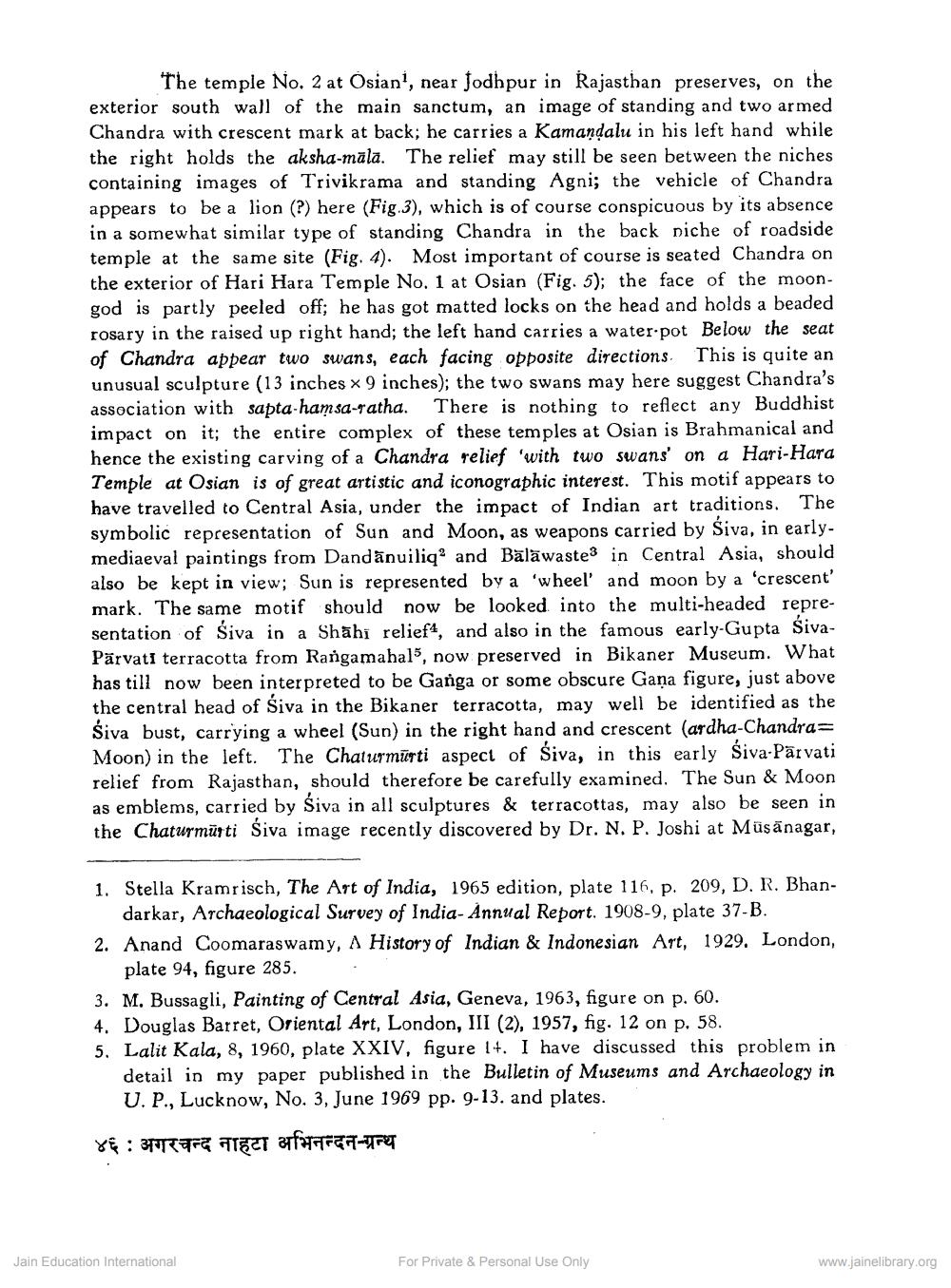________________
The temple No. 2 at Osian, near Jodhpur in Rajasthan preserves, on the exterior south wall of the main sanctum, an image of standing and two armed Chandra with crescent mark at back; he carries a Kamandalu in his left hand while the right holds the aksha-mala. The relief may still be seen between the niches. containing images of Trivikrama and standing Agni; the vehicle of Chandral appears to be a lion (?) here (Fig.3), which is of course conspicuous by its absence in a somewhat similar type of standing Chandra in the back niche of roadside temple at the same site (Fig. 4). Most important of course is seated Chandra on the exterior of Hari Hara Temple No. 1 at Osian (Fig. 5); the face of the moongod is partly peeled off; he has got matted locks on the head and holds a beaded rosary in the raised up right hand; the left hand carries a water-pot Below the seat of Chandra appear two swans, each facing opposite directions. This is quite an unusual sculpture (13 inches x 9 inches); the two swans may here suggest Chandra's association with sapta hamsa-ratha. There is nothing to reflect any Buddhist impact on it; the entire complex of these temples at Osian is Brahmanical and hence the existing carving of a Chandra relief 'with two swans' on a Hari-Hara Temple at Osian is of great artistic and iconographic interest. This motif appears to have travelled to Central Asia, under the impact of Indian art traditions. The symbolic representation of Sun and Moon, as weapons carried by Šiva, in earlymediaeval paintings from Dandanuiliq and Bäläwaste in Central Asia, should also be kept in view; Sun is represented by a 'wheel' and moon by a 'crescent' mark. The same motif should now be looked into the multi-headed representation of Siva in a Shahi relief, and also in the famous early-Gupta ŠivaParvati terracotta from Rangamahal, now preserved in Bikaner Museum. What has till now been interpreted to be Ganga or some obscure Gana figure, just above the central head of Siva in the Bikaner terracotta, may well be identified as the Šiva bust, carrying a wheel (Sun) in the right hand and crescent (ardha-Chandra= Moon) in the left. The Chaturmirti aspect of Siva, in this early Siva-Pärvati relief from Rajasthan, should therefore be carefully examined. The Sun & Moon as emblems, carried by Šiva in all sculptures & terracottas, may also be seen in the Chaturmirti Siva image recently discovered by Dr. N. P. Joshi at Müsanagar,
1. Stella Kramrisch, The Art of India, 1965 edition, plate 116, p. 209, D. R. Bhandarkar, Archaeological Survey of India- Annual Report. 1908-9, plate 37-B.
2. Anand Coomaraswamy, A History of Indian & Indonesian Art, 1929. London, plate 94, figure 285.
3. M. Bussagli, Painting of Central Asia, Geneva, 1963, figure on p. 60.
4. Douglas Barret, Oriental Art, London, III (2), 1957, fig. 12 on p. 58.
5. Lalit Kala, 8, 1960, plate XXIV, figure 1+. I have discussed this problem int detail in my paper published in the Bulletin of Museums and Archaeology in U. P., Lucknow, No. 3, June 1969 pp. 9-13. and plates.
४६: अगरचन्द नाहटा अभिनन्दन ग्रन्थ
Jain Education International
For Private & Personal Use Only
www.jainelibrary.org




